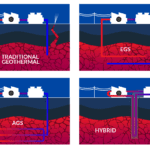Geothermal energy has been utilized by humans for millennia. While the first-ever use may be a mystery, we do know the Romans tapped into it in the first century for hot baths at Aquae Sulis (modern-day Bath, England). Since then, many other people and cultures have found ways to use the Earth’s underground heat to their benefit.
Geothermal resources were used for district heating in France as far back as 1332. In 1904, Larderello, Italy, was home to the world’s first experiment in geothermal electricity generation, when five lightbulbs were lit. By 1913, the first commercial geothermal power plant was built there, which expanded to power the local railway system and nearby villages.
However, one perhaps lesser-known geothermal concept revolves around energy storage. “It’s very much like pumped-storage hydropower, where you pump a lake up a mountain, but instead of going up a mountain, we’re putting that lake deep in the earth,” Cindy Taff, CEO of Sage Geosystems, explained as a guest on The POWER Podcast.
Sage Geosystems’ technology utilizes knowledge gleaned from the oil and gas industry, where Taff spent more than 35 years as a Shell employee. Like her, most of Sage’s team previously worked in the oil and gas industry. Today, the Houston, Texas–based company is working to advance three product lines: baseload power generation, district heating, and energy storage. The same subsurface technology platform is used for all three.
“What we do is we drill a well. We’re targeting a very low-permeability formation, which is the opposite of what oil and gas is looking for, and quite frankly, it’s the opposite of what most geothermal technologies are looking for. That low permeability then allows you to place a fracture in that formation, and then operate that fracture like a balloon or like your lungs,” Taff explained. “When the demand is low, we use electricity to power an electric pump. We pump water into the fracture. We balloon that fracture open and store the water under pressure until a time of day that power demand peaks. Then, you open a valve at surface. That fracture is naturally going to close. It drives the water to surface. You put it through a Pelton turbine, which looks like a kid’s pinwheel. You spin the turbine, which spins the generator, and you generate electricity.”
Unlike more traditional geothermal power generation systems that use hot water or steam extracted from underground geothermal reservoirs, Sage’s design uses what’s known as hot dry rock technology. To reach hot dry rock, drillers may have to go deeper to find desired formations, but these formations are much more common and less difficult to identify, which greatly reduces exploration risks.
Taff said traditional geothermal energy developers face difficulties because they need to find three things underground: heat, water, and high-permeability formations. “The challenge is the exploration risk, or in other words, finding the resource where you’ve got the heat, the large body of water deep in the earth, as well as the permeability,” she said. “In hot dry rock geothermal, which is what we’re targeting, you’re looking only for that heat. We want a low-permeability formation, but again, that’s very prevalent.”
When it comes to geothermal energy storage, the needed geologic formations exist just about everywhere in the continental U.S., including in the Northeast where the rock is a lot older and the heat is a lot deeper. “Once you get below about 5,000 feet, low-permeability formations are going to be prevalent for storage,” said Taff. “We’re wanting the surface temperature of the water to be less than 100 degrees C, so we don’t want to drill too deep where we’re getting too hot of water to surface.”
For district heating and power generation, on the other hand, Sage’s process requires both heat and pressure. “So, you’re going to have to drill deep enough to get those minimum temperatures that you need, and again, for geothermal, we’re looking for 150, 160 degrees minimum formation temperature. So, that limits you to where those hot spots are,” said Taff. She noted that geothermal energy could be used for district heating and power generation across about 35% to 40% of the lower 48 states.
Notably, the oil and gas industry has the know-how and experience to support geothermal well drilling today. “We’re using drilling rigs just like oil and gas. We’re using completion techniques such as fracturing—a little bit different from oil and gas because we use something called gravity fracking, but the equipment, the people, the skills, they’re pretty much a direct overlay to what we’re doing. Instead of drilling, though, for hydrocarbons, we’re drilling for heat,” said Taff.
Sage Geosystems completed a full-scale commercial energy storage pilot project and released findings in September 2023. The results show the company’s energy storage technology can provide power at a cost that is lower than lithium-ion battery storage and traditional pumped-storage hydro, and is also competitive with natural gas peaker plants.
The demonstration system reportedly produced 200 kW for more than 18 hours (long-duration) and 1 MW for 30 minutes (load-following), limited only by the small-diameter rental surface equipment piping. Measured subsurface system efficiencies were between 88% and 94%, with an estimated round-trip efficiency of 70% to 75%. Measured fluid losses were less than 2%, decreasing to 1% by the end of the five-week test period. The pilot demonstrated the ability to generate 2 MW to 3 MW net output in a single well.
Sage is now in the process of commissioning its first commercial energy storage project in Texas. “We’re testing the piping, and we’re function testing the generator and the Pelton turbine, so we’ll be operating that facility here in the next few weeks,” Taff said. Meanwhile, the company has also signed an agreement with the California Resources Corporation to establish a collaborative framework for pursuing commercial projects and joint funding opportunities related to subsurface energy storage and geothermal power generation in California. It also has ongoing district heating projects in Lithuania and Romania, and Taff said the U.S. Department of Defense has shown a lot of interest in the company’s geothermal technology. Additionally, Meta signed a contract for a 150-MW geothermal power generation system to supply one of its data centers.
To bring costs down even further, Taff said scale is needed. She suggested Sage Geosystems was only a few years away from scaling commercially. “I think there’s a lot of tailwinds that are helping us get there and helping us get there faster.”
To hear the full interview with Taff, which includes more discussion about Sage’s technology, progress on projects, how the oil and gas industry fits with the geothermal sector, government policies and incentives that are helping advance the geothermal industry, and much more, listen to The POWER Podcast. Click on the SoundCloud player below to listen in your browser now or use the following links to reach the show page on your favorite podcast platform:
For more power podcasts, visit The POWER Podcast archives.
—Aaron Larson is POWER’s executive editor (@AaronL_Power, @POWERmagazine).










